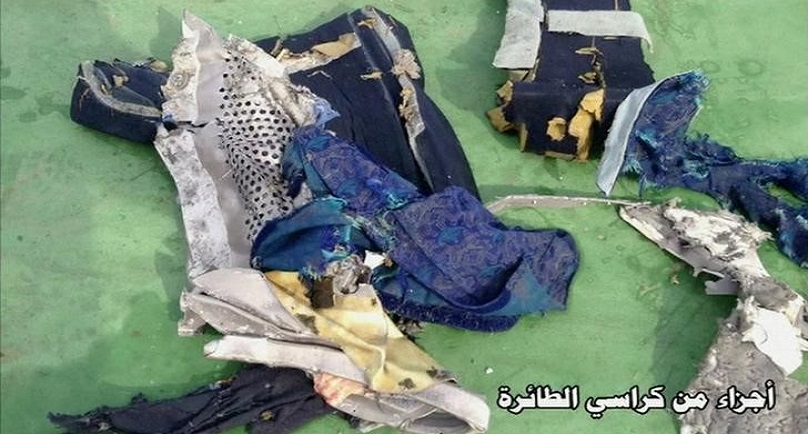Image:Recovered debris of the EgyptAir jet that crashed in the Mediterranean Sea is seen with the Arabic caption “part of plane chair” in this still image taken from video on May 21, 2016. Egyptian Military/Handout via Reuters TV
![]()
By Ahmed Aboulenein and Amina Ismail
CAIRO (Reuters) – Egypt has sent a robot submarine to join the hunt for an EgyptAir plane which crashed in some of the deepest waters of the Mediterranean Sea with 66 people on board, President Abdel Fattah al-Sisi said on Sunday.
Ships and planes scouring the sea north of Alexandria have found body parts, personal belongings and debris from the Airbus 320, but are still trying to locate the black box recorders that could shed light on the cause of Thursday’s crash.
Sisi said that underwater equipment from Egypt’s offshore oil industry was being brought in to help the search.
“They have a submarine that can reach 3,000 metres under water,” he said in a televised speech. “It moved today in the direction of the plane crash site because we are working hard to salvage the black boxes.”
An oil ministry source said Sisi was referring to a robot submarine used mostly to maintain offshore oil rigs. It was not clear whether the vessel would be able to help locate the black boxes, or would be used in later stages of the operation.
Air crash investigation experts say the search teams have around 30 days to listen for pings sent out once every second from beacons attached to the two black boxes. At this stage of the search they would typically use acoustic hydrophones, bringing in more advanced robots later to scan the seabed and retrieve any objects once they have been found.
EgyptAir flight 804 from Paris to Cairo vanished off radar screens early on Thursday as it entered Egyptian airspace over the Mediterranean. The 10 crew and 56 passengers included 30 Egyptian and 15 French nationals.
French investigators say that the plane sent a series of warnings indicating that smoke had been detected on board shortly before it disappeared.
The signals did not indicate what caused the smoke or fire, and aviation experts have not ruled out either deliberate sabotage or a technical fault, but they offered early clues as to what unfolded in the moments before the crash.
“Until now all scenarios are possible,” Sisi said in his first public remarks on the crash. “So please, it is very important that we do not talk and say there is a specific scenario.”
The crash was the third blow since October to hit Egypt’s travel industry, still reeling from political unrest following the 2011 uprising that ousted Hosni Mubarak.
A suspected Islamic State bombing brought down a Russian airliner after it took off from Sharm al-Sheikh airport in late October, killing all 224 people on board, and an EgyptAir plane was hijacked in March by a man wearing a fake suicide belt.
Islamic State claimed responsibility for the Sharm al-Sheikh bombing within hours but a purported statement from the group’s spokesman Abu Muhammad al-Adnani, distributed on Saturday, made no mention of the crash.
ANGUISH OF RELATIVES
EgyptAir has told relatives of the victims that recovering and identifying bodies from the sea could take weeks, adding to the pain and uncertainty of grieving families.
Samar Ezzedine, 27 years old and newly wed, was one of the cabin crew on flight 804. Her mother Amal has sat in the lobby of a hotel overlooking Cairo Airport, still waiting for her daughter to come back.
“She is missing, who hosts a funeral for a missing person?” she murmured.
Samar’s aunt, Mona, said Amal was reluctant to go home or even move away from the hotel door. “She doesn’t want to believe it … I told her to switch off her phone, but she said: What if Samar calls?”
An EgyptAir union appealed to Sisi to allow death certificates to be issued for the victims, to avoid the usual five-year delay in the case of missing people which leaves relatives in a legal limbo, including over pensions.
In his speech on Sunday, Sisi said the investigation would not be over quickly, but promised it would be transparent.
“This could take a long time but no one can hide these things. As soon as the results are out, people will be informed,” he told ministers and parliamentarians in the port city of Damietta.
The October crash devastated Egyptian tourism, a main source of foreign exchange for a country of 80 million people.
Tourism revenue in the first three months of the year plunged by two thirds to $500 million from a year earlier, and the latest incident could crush hopes for a swift recovery.
EgyptAir Chairman Safwat Moslem said the radius of the search zone was 40 nautical miles, but could be expanded. The radius is equivalent to an area of 5,000 square nautical miles (17,000 square km).
A European satellite spotted a 2 km-long oil slick in the Mediterranean, about 40 km (20 nautical miles) southeast of the aircraft’s last known position, the European Space Agency said.
(Additional reporting by Abdelnasser Aboelfadl and Eric Knecht in Cairo, Tim Hepher in Paris; Writing by Dominic Evans; Editing by Tom Heneghan)
Copyright 2016 Thomson Reuters. Click for Restrictions.


